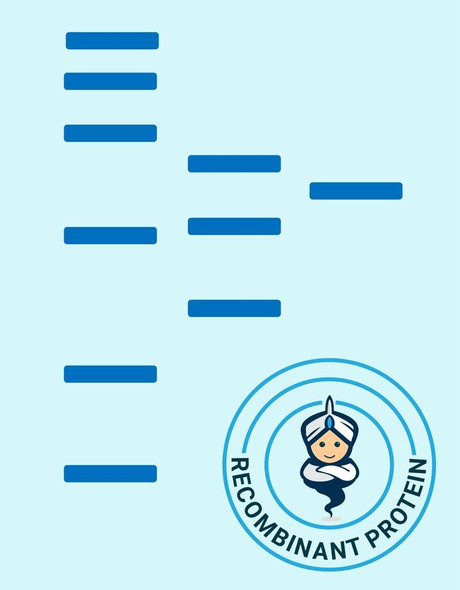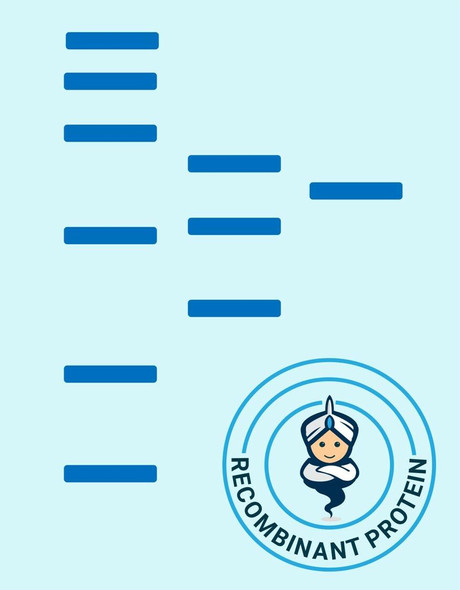Growth Factors & Cytokines Recombinant Proteins
Mouse Growth Hormone Recombinant Protein (RPPB0334)
- SKU:
- RPPB0334
- Product Type:
- Recombinant Protein
- Species:
- Mouse
- Uniprot:
- P06880
- Research Area:
- Growth Factors & Cytokines
Description
| Product Name: | Mouse Growth Hormone Recombinant Protein |
| Product Code: | RPPB0334 |
| Size: | 200µg |
| Species: | Mouse |
| Target: | Growth Hormone |
| Synonyms: | GH1, GH, GHN, GH-N, hGH-N, Pituitary GH, GH-1. |
| Source: | Escherichia Coli |
| Physical Appearance: | Sterile Filtered White lyophilized (freeze-dried) powder. |
| Formulation: | Mouse Growth Hormone Recombinant contains 20mM Tris-HCl, pH8.0, 150mM NaCl buffer, pH-8. |
| Solubility: | It is recommended to reconstitute the lyophilized Growth Hormone Murine in sterile 18M?-cm H2O not less than 100�g/ml, which can then be further diluted to other aqueous solutions. |
| Stability: | Lyophilized�GH mouse although stable at room temperature for 3 weeks, should be stored desiccated below -18°C. Upon reconstitution GH mouse should be stored at 4°C between 2-7 days and for future use below -18°C.For long term storage it is recommended to add a carrier protein (0.1% HSA or BSA).Please prevent freeze-thaw cycles. |
| Purity: | Greater than 95.0% as determined by SDS-PAGE. |
| Biological Activity: | Recombinant Mouse GH is fully biologically active when compared to standard Human�GH which is 3 units/mg. |
GH is a member of the prolactin family of hormones which play an important role in growth control. The gene, along with four other related genes, is located at the�GH locus on chromosome 17 where they are interspersed in the same transcriptional orientation; an arrangement which is thought to have evolved by a series of gene duplications. The five genes share a remarkably high degree of sequence identity. Alternative splicing generates additional isoforms of each of the five GHs, leading to further diversity and potential for specialization. This particular family member is expressed in the pituitary but not in placental tissue as is the case for the other four genes in the�GH locus. Mutations in or deletions of the gene lead to GH�deficiency and short stature.
Growth Hormone Mouse Recombinant produced in E.Coli is a single, non-glycosylated, polypeptide chain containing 190 amino acids and having a molecular mass of 22 kDa. Mouse GH is purified by proprietary chromatographic techniques.
| UniProt Protein Function: | GH: Plays an important role in growth control. Its major role in stimulating body growth is to stimulate the liver and other tissues to secrete IGF-1. It stimulates both the differentiation and proliferation of myoblasts. It also stimulates amino acid uptake and protein synthesis in muscle and other tissues. Defects in GH1 are a cause of growth hormone deficiency isolated type 1A (IGHD1A); also known as pituitary dwarfism I. IGHD1A is an autosomal recessive deficiency of GH which causes short stature. IGHD1A patients have an absence of GH with severe dwarfism and often develop anti-GH antibodies when given exogenous GH. Defects in GH1 are a cause of growth hormone deficiency isolated type 1B (IGHD1B); also known as dwarfism of Sindh. IGHD1B is an autosomal recessive deficiency of GH which causes short stature. IGHD1B patients have low but detectable levels of GH. Dwarfism is less severe than in IGHD1A and patients usually respond well to exogenous GH. Defects in GH1 are the cause of Kowarski syndrome (KWKS); also known as pituitary dwarfism VI. Defects in GH1 are a cause of growth hormone deficiency isolated type 2 (IGHD2). IGHD2 is an autosomal dominant deficiency of GH which causes short stature. Clinical severity is variable. Patients have a positive response and immunologic tolerance to growth hormone therapy. Belongs to the somatotropin/prolactin family. 4 isoforms of the human protein are produced by alternative splicing. |
| UniProt Protein Details: | Protein type:Secreted, signal peptide; Secreted; Hormone Cellular Component: extracellular space; mitochondrion; plasma membrane; extracellular region; trans-Golgi network; cytosol; nucleus; secretory granule Molecular Function:growth hormone receptor binding; hormone activity; metal ion binding Biological Process: response to food; response to light stimulus; positive regulation of neurogenesis; cellular response to insulin stimulus; neuroblast proliferation; positive regulation of multicellular organism growth; regulation of steroid hormone receptor signaling pathway; glucose transport; signal transduction; alveolus development; positive regulation of growth |
| UniProt Code: | P06880 |
| NCBI GenInfo Identifier: | 134708 |
| NCBI Gene ID: | 14599 |
| NCBI Accession: | P06880.1 |
| UniProt Secondary Accession: | P06880,Q544X1, |
| UniProt Related Accession: | P06880 |
| Molecular Weight: | 24,716 Da |
| NCBI Full Name: | Somatotropin |
| NCBI Synonym Full Names: | growth hormone |
| NCBI Official Symbol: | Gh�� |
| NCBI Official Synonym Symbols: | Gh1�� |
| NCBI Protein Information: | somatotropin |
| UniProt Protein Name: | Somatotropin |
| UniProt Synonym Protein Names: | Growth hormone |
| Protein Family: | Growth hormone |
| UniProt Gene Name: | Gh1�� |
| UniProt Entry Name: | SOMA_MOUSE |






